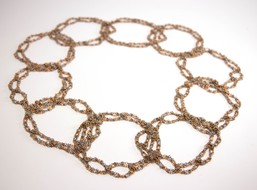Antoine's Necklace
 Antoine’s Necklace. Image credit : © Edmund Harris
Antoine’s Necklace. Image credit : © Edmund Harris
The Cantor set is one of the simplest fractal object. Its ternary representation is obtained by a recursive procedure: start with a segment of length one and remove the middle third; for each of the two remaining segments, remove again the middle third; and so on. After an infinite number of steps, the remaining object is the Cantor set and looks like dust. More abstractly, it is the unique non-empty metrizable, compact, totally disconnected set, without isolated point.
For a long time topologists where intrigued by the embeddings of a Cantor set in the 3-dimensional Euclidean space. In particular, they ask if it is possible to find such an embedding so that there exists a loop in $\mathbf R^3$ which cannot be shrunk to a point without crossing the Cantor set. Said differently, does there exits an embedding of the Cantor set in $\mathbf R^3$ whose complement is simply-connected? The ternary Cantor set described above does not satisfy this property. Nevertheless, the question was answered positively by Louis Antoine at the beginning of the XXth century. This embedding is known as Antoine’s necklace . It is a necklace, whose links are themselves a necklaces, whose links…
This piece represents the first four levels of the Antoine’s necklace. It is made of 10, 000 links which I opened and closed individually.


